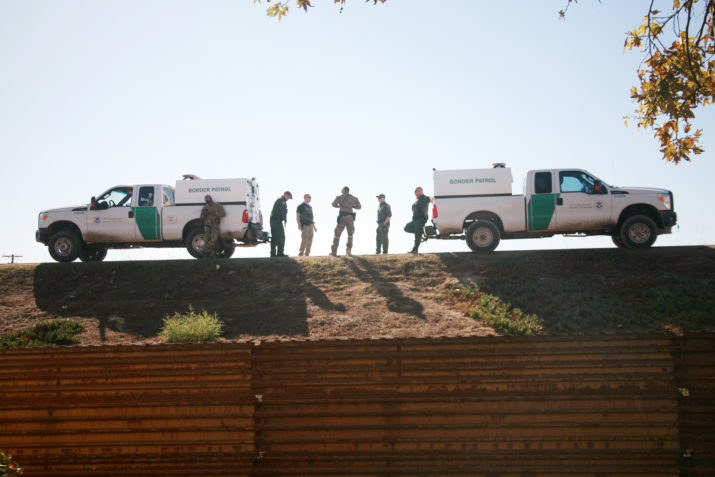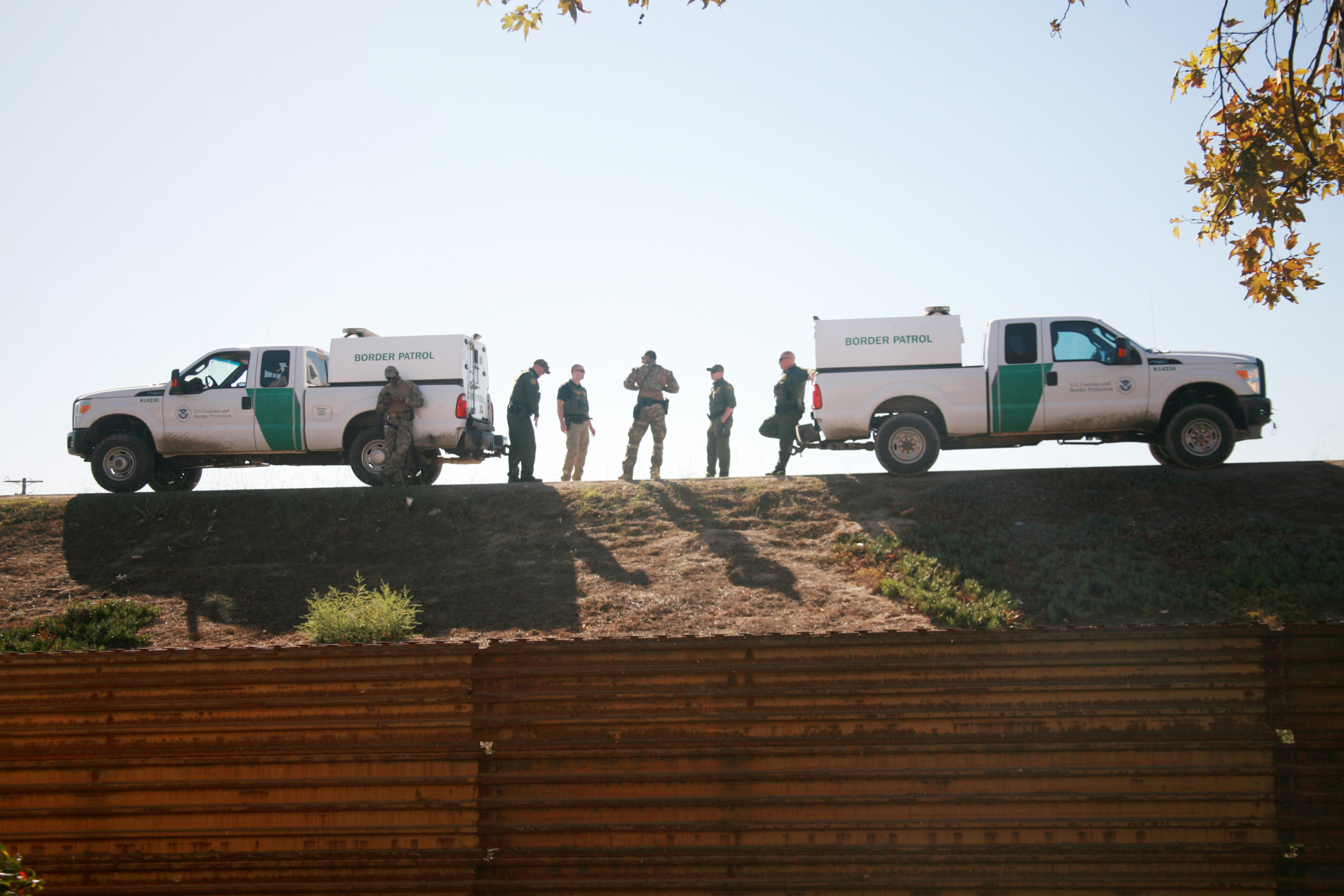
Bard College Border Pedagogy: Experiential Learning, Syllabi, and a Model Unit on Encounters with Border Patrol

Since the launch of the Consortium on Forced Migration, Displacement, and Education in 2016, it has been hard to avoid feeling overwhelmed by urgency. In the United States, the Trump administration has pried at the seams of an already troubled immigration system to impose extreme anti-immigration measures. Anti-Muslim policies, family separation, a border wall, dramatic limits on refugees and asylum, and ramped-up use of a militarized border police in other parts of the country are just some of the policies that build on longer histories of exclusion, violence, and xenophobia. In the view of many, the COVID-19 crisis served primarily as an opportunity for even more draconian actions.
For those who are paying attention, there is a war going on, most visibly at the US-Mexico border, but more insidiously across the country, where attacks on undocumented people lead to daily and potentially catastrophic disruptions to their lives. For others, it all seems far away and abstract. Were there really children in cages? In Upstate New York, where our college is located, the migrant world is as obvious to some as it is invisible to others. For faculty, staff, and students in our college who come from migrant communities under siege, this disconnect—in classrooms and among peers—can be searing.
In early 2020, we drew on the resources of the Consortium to launch the Border Pedagogy Working Group, an interdisciplinary group of faculty and students interested in developing materials and identifying programs that would make the border legible in new ways. At the same time, and in collaboration with a group of Bard students, we convened a Spring tutorial that sought to explore the urgency of the border crisis and the context necessary for grasping it. The tutorial combined ‘traditional’ readings (think tank reports, Supreme Court decisions, academic writing) with YouTube videos, Twitter threads, podcasts, and anthropologist Jason de Leon’s installation project about migrant deaths, titled Hostile Terrain 94. Not coincidentally, each student’s relationship to the border was central to their participation in the tutorial. One student, who crossed the southern border with her father in 2015, lost her asylum hearing right before the COVID-19 shutdown sent us all home.
Three of the students continued with us this summer to work on discrete pieces of the Working Group’s project. What you will read here are reflections on this research, with links to the projects-in-progress, each of which is intended as a critical tool and resource for teaching. Hattie Karlstrom explored the role and opportunities for experiential learning. Giselle Avila combed through available syllabi and course descriptions to draw out recurring themes and key material to suggest ways of bringing the border into classes where it is less obvious. Lily Chavez worked on a project that grew out of our tutorial’s central concern: Where is the border, and who exercises its authority? She created a compilation of YouTube videos of encounters with Border Patrol, along with resources to interrogate them through law, history, and theory.
Taken together, these projects constitute a line of thinking about how we can strengthen our Consortium’s pedagogical approach to borders, which we hope to develop further with the Working Group going forward.
Peter Rosenblum is Professor of international law and human rights at Bard College, and the Bard faculty director for the Consortium on Forced Migration, Displacement, and Education. He is the co-leader of the Border Pedagogy Working Group.
Danielle Riou is the Associate Director of the Human Rights Project at Bard College, and the Bard coordinator for the Consortium on Forced Migration, Displacement, and Education. She is the co-leader of the Border Pedagogy Working Group.
Experiential Learning and Border Pedagogy
Hattie Wilder Karlstrom
In Spring 2019, I began researching the history of the US-Mexico border for my Senior Project at Bard College. Having been homeschooled, I had a foundation of experiential learning and felt a conviction that I could only do intellectual justice to the history of the US-Mexico border—only understand how to connect it to the fight for human rights—by experiencing it. The humanitarian and political crisis at the border has a place in the classroom; I believe it also demands that students understand the border in visceral and experiential ways. Personally, I wanted to understand firsthand how a border, drawn across contiguous land, affected the lives in contact with it. To share this, I created a spreadsheet of experiential learning opportunities for future students.
In 2019, Bard did not offer experiential learning about US borders and migration; I had to create my own. I took the Fall semester off and traveled to the southern border. The first component of my self-made program consisted of volunteering for a month with Annunciation House in El Paso, Texas—an organization that has assisted asylum seekers in the US since 1978. The second was a month with No More Deaths, an organization founded in 2004 to prevent death and suffering in the Sonoran Desert. During these months at the border, I learned about asylum law, heard heart-wrenching stories from those most dependent on it, and experienced how a room can brighten as people are freed from ICE detention. I learned that Border Patrol relies on deaths in the desert to deter migration, and that this does not work. As I walked the desert, there was always the possibility of finding a corpse. I sat in a courtroom as Mexicans and Central Americans faced a judge, wrists and ankles chained, each granted forty seconds before sentencing and deportation through “Operation Streamline.” Finally, I volunteered as “court support,” as my Federal government tried No More Deaths volunteer Scott Warren in a (failed) attempt to criminalize humanitarian aid.
Educational philosopher David Kolb defines experiential learning as learning through reflection on doing, and outlines four stages: concrete experience, reflective observation, abstract conceptualization, and active experimentation. Kolb acknowledges that we receive information through concrete experience (hands-on experience) and abstract conceptualization (what we can learn in a classroom), and transform that information through reflective observation (discussion/personal journaling) and active experimentation (testing new ideas). Since the 1960s, higher education institutions have been introducing experiential learning into many areas of study, including Border Studies. While I didn’t encounter Kolb’s work until recently, it captures what I valued in my homeschooling, and my border experience.
My border experience was potent, and while Kolb’s theories frame much of what I did, there was an element of disparity, a divide between volunteer and migrant, that demanded recognition. This is captured by educational philosopher David Meens, who raises concerns about experiential learning’s tendency to idealize the disadvantaged student in Border Studies, particularly for more privileged (white) students from private institutions. While traditional models are implicitly aimed at empowering students, Meens states that “Democratic renewal may, in many contexts, require that privileged citizens exert less power, become more receptive to the experiences and claims of less advantaged others, and be more able to listen” (Meens 49). Thus, while the empowerment to do is desired in experiential learning, not all students need empowerment in the same way; “some students need to learn skills associated with receptivity rather than activity and agency” (Meens 50). Although I did not explicitly build this into my border experience, I couldn’t avoid addressing my own privileges in the presence of the courageous migrants who risk everything to find life beyond survival, and the dedicated activists who help them. I found it essential to decenter myself and I believe any program wishing to implement experiential learning about borders must incorporate room for reflection on privileges, and foreground migrant voices.
Upon returning to Bard, I joined the Border Pedagogy Working Group and began researching Border Studies experiential learning options for college students. I reached out to my network involved in border issues, spoke to those still in the border region, and researched existing programs. From this work, I created a spreadsheet of possibilities for Bard’s engagement in Border Studies experiential learning both locally in New York’s Hudson Valley and at the US-Mexico border. Four main categories of experiential programs emerged: alternative spring breaks; summer and winter month-long programs (stand alone or embedded within academic courses); semester-long study abroad programs; and external institutions’ border awareness programs. While some of these existing programs have limited funding, and COVID-19 has posed a unique challenge to all forms of learning, border injustices remain abundant, pointing to the necessity of personal, experiential education in this area.
I envision this spreadsheet as a guide for students who wish to engage in experiential learning concerning the border, as well as models for Bard College and other institutions to create their own programs. Given my experiences, I am drawn to working with independent organizations who center migrant voices. If incorporated, Annunciation House’s Border Awareness Experience, a BorderLinks Experience, or an alternative spring break with the Rural Migrant Ministry in New York, could introduce experiential learning into Bard’s migration curriculum. This model would resemble what I created for myself: a diverse learning experience regarding the border, which provided a well-rounded understanding of the border’s history, Border Patrol policies, and the human realities of migration and asylum-seeking in the US. I hope my research makes experiential learning more available to students who are driven to learn about border and migration issues, to help fight knowledgeably for social justice and human rights.
Hattie Wilder Karlstrom graduated from Bard College in May 2020, after completing a senior thesis about the creation of the US-Mexico border in the 1800s. While writing this thesis, she took time off to volunteer at the US-Mexico border, providing humanitarian aid to migrants, and is now interested in pursuing a career in immigration law. She is currently working as an Assistant Coach for the Bard Women’s Soccer team while she awaits her departure on a Watson Fellowship—delayed due to the pandemic—in which she will travel to border regions around the world, using soccer and music to cultivate community across linguistic and cultural divides.
A Call for Action: Bringing Migration Studies to Unconventional Disciplinary Spaces
Giselle Avila
My father was twenty years old when he embarked on a treacherous two-month journey from Cuenca, Ecuador to New York, USA. He said a prayer to the Virgin Mary, kissed his mother goodbye, and hugged his eight younger siblings, not knowing it would be twenty-five years until they’d meet again. For years he shied away from sharing his border experience and the conditions that forced him to migrate. However, the 2016 US presidential election made him understand that his story was one shared by thousands of other migrants and must be recognized by young scholars like myself who have the opportunity and ability to uplift their voices. In order to honor my father’s journey, I needed to use my privilege as a scholar in higher education spaces to educate others, as well as myself on all aspects of migration. It is my goal to bridge people’s gaps of understanding by bringing conversations of immigration to unconventional spaces that do not intentionally or actively seek to include it. It is through the incorporation of migration studies in diverse fields that powerful conversations of immigration reform and change can be held by scholars of all disciplines. This led me to my summer research project of collecting and organizing syllabi that fully integrate border and migration studies into specific fields of study.
In the course of my work to bring migration conversations into other disciplinary spaces, I discovered the online #ImmigrationSyllabus, which offers a historical account of the various ideologies that have contributed to the current structure of the US immigration system. The University of Minnesota, in partnership with the Immigration and Ethnic History Society, launched the #ImmigrationSyllabus with fifteen weeks of material selected by over thirty consultants. The syllabus moves the reader from recognizing the value of studying immigration to understanding how the US has become a deportation nation. I discovered other versions of #ImmigrationSyllabus that focused on specific aspects of immigration, with the same intention of offering a platform for discussion. For example, the non-profit Freedom For Immigrants created the Immigration Detention Syllabus, a sixteen-part series of readings, art, multimedia resources, and personal accounts with the purpose of examining and dismantling the US immigration detention system. The NYU Sanctuary Coalition similarly constructed a Sanctuary Syllabus that traces the history of sanctuary in America and extends these ideas to the protection of Latin American refugees fleeing violence historically incited by the US. These syllabi are all accessible, and part of a larger movement calling for the recognition of the nation’s long and complicated relationship with immigrants.
Given the breadth of the existing efforts, and my own commitments to bring conversations about migration to new spaces, I did not want to create another immigration syllabus bank that would offer the same resources as the previously mentioned syllabi. There must also be a push to teach about immigration in divisions with less obvious connections to it. It is crucial for students majoring in Computer Science for example, to understand their knowledge has the power to make large contributions to the lives of migrants. Mercy Corps, a humanitarian aid organization, is constructing a blockchain database to create a digital identity for migrants and refugees to expand their access to resources. Techfugees, an international non-profit, is trying to ease the difficulties of integration by creating an app that provides information of a migrant’s new home in their native language. The goal is to have students from disciplines that do not typically address themes of border/migration studies recognize they too have a place in this conversation. For this reason, I dedicated my summer research to creating a syllabus bank that touches over fifteen disciplines that contain syllabi focused on migration. I visually diagrammed central themes and recurring texts to understand each division’s approach to the topic.
As I scrutinized hundreds of different syllabi, I separated the ones that truly captured the idea of my research; classes that incorporated immigration topics in unconventional ways. I labeled these “model syllabi”—syllabi that I hope will inspire professors to incorporate similar critical thinking into their classes. For example, one of the model syllabi is an Urban Studies and Planning Course offered at MIT, “Cities and Immigration: Law and Policy.” This class focuses on how urbanized cities are being reshaped by immigrants, and uses law cases to study changes in identity, assimilation, and multiculturalism within both American and migrant communities. Other examples included Economics classes that concentrated on how theories of development contribute to global displacement, and Philosophy classes that use different political texts to answer questions of land ownership, citizenship rights while exploring identity social groups within immigrant communities. I even encountered final projects where Cornell College students created interactive computer games to teach the history of immigration to high school and elementary students. I also constructed a resource list composed of suggested readings, films, artwork and central texts used in syllabi that only incorporated immigration as subdivisions.
Drawing on the rich data banks of existing syllabi on migration, immigration, and border studies, I made editorial choices to highlight how educators and students might benefit from breaking out of disciplinary silos. At the same time, the rich collection of syllabi I discovered and collated might benefit a more general public interested in learning more about (im)migration.
Immigration is a truly interdisciplinary issue, and institutions must marshal a wide range of perspectives to help students think critically. It is my hope that by offering a curated list of syllabi, as well as a list of central themes, texts, and resources pertaining to a wide variety of disciplines, I can contribute to the growing field of migration and border studies.
Giselle Avila is a recent Bard College graduate who studied Political Science and completed a senior thesis analyzing the U.S. Immigration system under the Trump Administration in connection to principles of cosmopolitanism. During her undergraduate career she worked as an editorial assistant for the Spanish-language publication La Voz and as a programming intern for Bard’s office of Equity and Inclusion. Her volunteer work ranges from immigrant advocacy organizations such as Nobody Leaves Mid-Hudson to Congresswoman Alexandria Ocasio-Cortez’s re-election campaign. Giselle is currently working as a legal assistant and Spanish translator for a personal injury law firm located in Queens, New York and aspires to pursue a career in immigration law.
Border Encounters on YouTube: The Intersection of Securitization and Multimedia
Lily Chavez
*please note that several examples are linked directly in the text below.
Two transformations that define the turn of the twenty-first century in the United States are the increasing securitization of national borders and the rise of social media. These phenomena may appear discrete, but at their intersection has emerged a new “eyewitness” phenomenon: people filming their encounters with Border Patrol officers. Since the creation of the Department of Homeland Security and the expansion of Customs and Border Protection checkpoints across the US, encounters with border agents have become routine for many people, yet for the majority, the border remains a distant concept. The rise of smartphone cameras and YouTube has allowed those who live beyond the border’s reach to view these encounters at the click of a button.
I was first introduced to these videos in my class Border Dynamics from Guatemala to Upstate New York class. Later, I joined the Border Pedagogy Working Group, and was tasked with finding as many YouTube videos as possible, creating transcripts and summaries for each. Some encounters highlight the dissonance between the border’s jurisdiction and individual constitutional rights. Others reveal complex social and racial dynamics requiring a more nuanced analysis. Collectively, these Youtube videos raise the question of how “televised” encounters, while shedding light on specific practices of border enforcement, may shape our understanding of the border in ways that obscure the violence required to maintain it.
One example stands out: Encounter with SD Border Patrol features a group of American theater actors in San Diego who, following a pre-arranged tour of the border given by a Border Patrol agent, are mistaken by other agents as traffickers of two migrants nearby. We see their surprise in the face of such a serious accusation, followed by the group’s emphatic disavowal of the two strangers standing nearby. I was struck by their incredulity at being held in the grip (if only momentarily) of a violent space they had felt was safe to tour only moments before. Surely, I thought, the group (whose tour was intended as research) understood this border has a well-documented history of violence. People attempting to cross it have long been subjected to routine indignities and violations—some a direct result of US policy, and others seemingly at the whim of border patrol agents.[1] I read the group’s disavowal of the migrants as evidence of a system that encourages apathy in violent situations—so long as the violence targets a subject for whom it is considered appropriate. The video foregrounds the exchange between border agents and the theater group, positioning the plight of the migrants as a threat to their (legal) status and thus obscuring the violence the migrants face. It reveals the power of the border: we watch as each person’s whole identity is reduced to a legal category, and in that momentary distinction (and disavowal), the possibility of acknowledging a shared humanity—among the theater group, the migrants, and the border agents—is obliterated. I do not wish to ascribe blame to individuals here, but instead question a legal and cultural framework that permits a space to be the site of manifold dangers to some, while being a tourist destination for others.
The experience of deconstructing this video and others like it led my analysis to the production, circulation, and consumption of border encounters as “content,” and how these patterns contribute to the discursive construction of the border. I witnessed videos that were impromptu recordings uploaded as public service messages, but there are also creators who build a vast following through the promise of recurring, premeditated checkpoint refusals. Many of these refusal videos explicitly perpetuate a political ideology, often libertarianism, which leads me to consider how such endorsements obscure or reframe any encounter the viewer witnesses. Even without an explicit political agenda, the very presence of a disruptive actor, camera in hand, at a checkpoint invokes a classic anthropological question: can a person observe a society without fundamentally disrupting that society? Is it possible for a camera to be present at a checkpoint encounter without transforming the dynamics of that encounter? The scope of these questions cannot be adequately addressed here, but they are part of our ongoing examination of these videos. What I can say here is that while these videos raise several issues, they are also the means by which we can grapple with these issues when presented in a classroom context.
Importantly, one of the challenges in locating the violence of the border—here I not only mean the boundary between two countries, but the vast federal apparatus that enforces its authority—is simply because many of us do not see it. People who have proximity to the border, or who have encounters with Border Patrol, are more readily able to connect academic discussions of “the border” to the routine human interactions that its enforcement requires. Close ‘readings’ of these videos in a classroom could allow for a more thorough analysis of the human infrastructure of the border, provided both student and teacher responsibly adopt the role of active witness—remaining attentive not only about the content at hand, but to how it is produced and consumed. To that end, I present the collection of videos along with the additional resources I created to contextualize the videos. Viewers should think critically about what the presence of the camera means in these videos, and try to situate all of the actors in them, through research and critical thinking. Our Working Group will continue to develop analytical approaches to these videos for use in the classroom; this brief summary of our work-in progress is, I hope, a good start.
Lily Chavez, a recent graduate of Bard College, majored in Global and International Studies and completed a thesis titled “Sovereign Violence: Migrants, Borders, and the Brutal Logic of Nationhood.” During her time at Bard, she co-lead a program that provided academic and social assistance to elementary students belonging to local migrant communities, and assisted legal advocacy for refugees and survivors of sex trafficking. Lily currently works as a researcher and fact-checker for an upcoming book regarding refugee students in the US public school system, and hopes to further dedicate herself to border abolition and migrant advocacy in the future.
References:
[1] Aside from frequent newspaper and magazine reporting about the US-Mexico border, much academic work has focused on different forms of violence that occur at (or in the name of) the border. See for example: Reece Jones, Violent Borders (New York: Verso, 2016); Jason De León and Michael Wells, The Land of Open Graves: Living and Dying on the Migrant Trail (Oakland, California: University of California Press, 2015); Mae Ngai, Impossible Subjects: Illegal Aliens and the Making of Modern America (Princeton: Princeton University Press, 2014); Nicholas De Genova, “Spectacles of migrant ‘illegality’: the scene of exclusion, the obscene of inclusion,” Ethnic and Racial Studies 36, no. 7 (2013); Kelly Lytle Hernandez, Migra! The History of the Border Patrol (Oakland, California: University of California Press, 2010) ; Joseph Nevins, Operation Gatekeeper: The Rise of the “illegal Alien” and the Making of the U.S.-Mexico Boundary (New York: Routledge, 2002.)
Kolb, David A. Experiential Learning: Experience as the Source of Learning and Development. Pearson Education, Inc., 2015.
Meens, David. “Democratic and Social Justice Goals in Service-Learning Evaluation: Contemporary Challenges and Conceptual Resources.” Michigan Journal of Community Service Learning, vol. 21, no. 1, 2014, pp. 41-54.http://hdl.handle.net/2027/spo.3239521.0021.104
Photo: San Yasidro, California – 11/26/2018: Border patrol agents discuss their next moves and survey the landscape at the US Mexico Border. Government and Border agents are all on High Alert | Shutterstock
Published on October 13, 2020.




